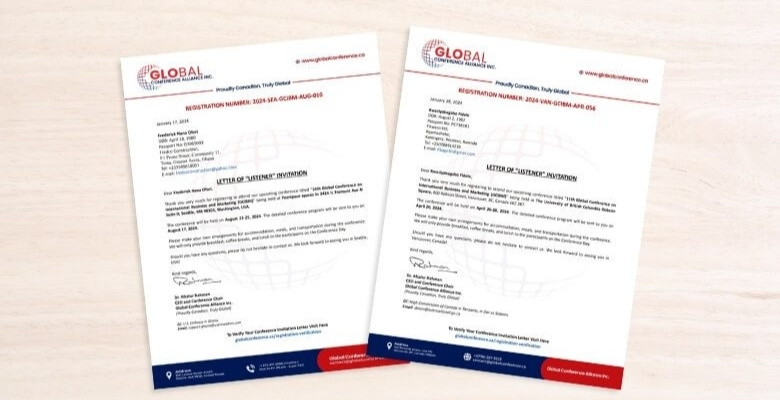Inviting someone to a conference is more than just sending an email; it’s about triggering interest and making the person feel their presence is valued. The right invitation sets the tone and can strongly influence whether someone decides to attend.
When you think about how to invite someone to a conference, the key lies in balancing clarity with warmth. Your message should answer the basic questions while also giving a reason to take action. A well-crafted invite makes the event feel like an opportunity, not just another obligation.
By keeping your wording clear, timing thoughtful, and approach personal, you create an invitation that stands out. Let’s explore the steps and examples that can help you put together an invite people will be glad to accept.
How to Invite Someone to a Conference?
Inviting someone to a conference goes beyond sending a quick note. A strong invite shows that you value their presence, provides all key details, and highlights the benefits of attending. When done right, it increases both responses and overall participation.

Step 1: Understand the Conference
Before writing any invitation, you need to fully understand your own conference. Know the theme, purpose, and main objectives, along with who it’s designed for. This clarity helps you craft a message that speaks directly to the invitee and explains why it matters.
Step 2: Identify the Right People
Not every conference is for everyone. Take time to select the people who would benefit most from the sessions and discussions. Think about their professional background, current interests, and what they can gain from attending. Relevance increases acceptance and ensures active participation.
Step 3: Draft the Invitation
When drafting, focus on clarity. Your conference invite must include the invitee’s name, the conference title and purpose, date and time, venue or online link, organizer details, and RSVP instructions. Keep the tone welcoming, simple, and professional so that the recipient feels confident about attending.
Here’s an example:
Subject: Invitation to Join [Conference Name] – [Date]
Hi [First Name],
Hi [First Name],
We’re excited to invite you to the upcoming [Conference Name], taking place on [Date] at [Venue/Online Platform]. The event will feature [topics/speakers] and bring together [audience profile].
Please confirm your spot by [RSVP date] using this link: [Registration Link].
Warm regards,
[Your Name]
[Your Organization]
Tone: Informative and complete, covering all key details in a professional but friendly way.
Step 4: Add a Personal Touch
Nobody likes a generic invite. Add one or two lines tailored to the person you’re inviting—such as mentioning their work, expertise, or interest in a topic being covered. Personal touches make the invited person feel valued and increase the likelihood of a positive response.
Step 5: Choose the Right Medium
Email works for most invitations, but sometimes another channel makes more sense. For example, a speaker may respond faster to LinkedIn, while local partners might appreciate a printed letter. No matter the format, an invitation for conference should match the relationship and the formality of the event.
Step 6: Send Well in Advance
Give people plenty of notice so they can plan ahead. For general attendees, sending invites 4–6 weeks before the event works well. For speakers, sponsors, or VIPs, send them earlier. Early invites also allow you to send reminders without overwhelming people.
Step 7: Follow Up
One invitation is rarely enough. Send a reminder about a week after your first message, then another just before the RSVP deadline. Keeping a conference invitation letter consistent across initial and follow-up messages makes your communication professional and easy to recognize.
A good invitation balances professionalism with warmth. When you give people the right details, personalize your message, and follow up at the right time, your invite feels less like a notice and more like an opportunity. That’s what makes people say yes.
Essential Elements of a Strong Conference Invitation
A well-crafted invitation is like the doorway to your event; it’s the first impression and often the deciding factor for attendance. While many invites cover the basics, a strong one goes a little further to make things clear, warm, and professional. Let’s look at the key details every invite should include.
Invitee’s Full Name and Role
Always address the person by their correct name and role. Using a full name and professional title shows respect and attention to detail. It makes the invite feel personal rather than generic, which can greatly increase the chance of a positive response.
Title of the Conference + Description
State the exact title of the conference and follow it with a short description. This should highlight the main theme or focus of the event. Keep it simple and easy to grasp so the invitee immediately knows what the conference is about.
Date, Time, and Venue Details
Never leave people guessing about when and where. Clearly mention the date, starting and ending time, and the exact venue. If it’s online, include the platform link. Giving this information upfront saves time and avoids confusion later.
Organizers’ Names
Mentioning the names of the organizers builds trust. People want to know who is behind the event before committing. Listing the organization or hosting body adds credibility and reassures invitees that the conference is authentic and well-structured.
Joining/Registration Instructions
Tell the invitee exactly how to secure their spot. Whether it’s through a registration link, an attached form, or a simple RSVP reply, make the process straightforward. Clear joining instructions reduce friction and make it easy for them to say yes.
RSVP Deadline and Call-to-Action
Always set a clear RSVP deadline. Without it, people might delay and forget to respond. Add a direct call-to-action like “Register here” or “Confirm your attendance today” so invitees know the next step right away.
These elements form the backbone of a strong conference invitation. Whether you’re organizing academic events, trade shows, or business conferences, covering these basics ensures your message looks professional, easy to follow, and welcoming – giving you a much better chance of getting confirmed responses.
Follow-up Sequence and Best Timing
Sending a single invitation is rarely enough to get strong attendance. People are busy, emails get lost, and sometimes they just need a small reminder. That’s why having a simple follow-up plan makes all the difference. Let’s break it down into easy steps you can use.
3-Touch Email Cadence
Think of your invite process as a short sequence instead of one message. Start with the initial invitation that gives all details. About a week later, send a polite reminder highlighting the main benefits of attending. Then, as the RSVP deadline approaches, send one final push that creates urgency without sounding forceful. This three-step approach keeps the event top of mind without overwhelming your contacts.
Best Send Times
Timing matters almost as much as the message itself. Research shows that mid-mornings on Tuesday, Wednesday, or Thursday are ideal starting points, since people are usually more active with emails during these times. While this works as a baseline, test your own audience to see what gets the best response rate. Sometimes even a small shift in timing can make a big difference.
RSVP Confirmation Strategies
Getting a “yes” is great, but securing that confirmation is even better. Always provide a clear RSVP button or link in your emails, making it easy for people to confirm in just one click. You can also send a short acknowledgement message once someone registers. This simple confirmation reassures them that their spot is saved and helps reduce no-shows.
Here’s a simple example you can adapt:
Subject: Friendly Reminder – [Conference Name] on [Date]
Hi [First Name],
I just wanted to gently remind you about [Conference Name], happening on [Date] at [Venue/Online Platform]. We’re welcoming participants from [industries/fields], and your presence would add great value to the discussions.
If you haven’t registered yet, please secure your spot here: [Registration Link]. We’d be glad to have you join us.
Warm regards,
[Your Name]
[Your Organization]
Tone: Shorter, lighter, and focused on nudging action without repeating the full details
A thoughtful follow-up sequence combined with smart timing can boost your attendance significantly. By reminding people at the right moments and making it simple to confirm, your invitation conference messages turn from a forgotten email into an event they’re eager to attend.
Pre-Invite Readiness Checklist
Before you hit send on a conference invitation, it helps to pause and make sure you’re fully prepared. Knowing how to invite people to an event the right way can prevent mistakes. A few small checks can save you from missed opportunities or overlooked details. Here’s a quick checklist to run through before inviting anyone.
Quick Checklist:
- Confirm the relevance of the invitee
- Define value proposition
- Prepare CTA/landing page
- Ensure compliance (GDPR/opt-in)
- Personalization tokens ready
Confirm Relevance of Invitee
Every conference has a specific purpose and audience. Inviting people who have little connection to the theme only lowers engagement. Take time to confirm that your invitee’s expertise, role, or interest aligns with the event. This makes the invite more meaningful and increases the likelihood of participation.
Define Value Proposition
Think about what the invitee gains by attending. Whether it’s learning from experts, networking with peers, or discovering industry trends, spell it out clearly. If you can’t define a real benefit for them, they won’t see a reason to say yes.
Prepare CTA/Landing Page
Once you’ve convinced someone to attend, the next step should be effortless. Make sure your call-to-action is strong and your registration link or landing page is working smoothly. A broken or confusing sign-up process can quickly turn interest into frustration.
Ensure Compliance (GDPR/Opt-in)
If you’re sending invites to a wide list, always respect data privacy laws. Confirm that your contact list is permission-based and compliant with GDPR or local rules. Apart from avoiding penalties, it shows professionalism and builds trust with your audience.
Personalization Tokens Ready
Personal touches go a long way. Before sending, check that names, roles, or organizations are correctly set up in your email system. Nothing feels worse than receiving an invite that says “Dear Attendee.” Double-check these tokens to avoid small but costly mistakes.
Running through this checklist only takes a few minutes, but it makes your conference invitations sharper, smoother, and more respectful. The result is better engagement and stronger responses, which ultimately means a more successful event.
Conference Visa Invitation Letter: What to Include?
For international attendees, the invitation letter is more than just a formality—it’s often a required document for securing a travel visa. Without it, participants may face delays or even be unable to attend. A clear, professional letter ensures smoother processing and helps guests feel confident about making the trip. Let’s go through what it should include.
Why It Matters
International participants usually need to present an official letter when applying for a visa. This letter confirms the event’s purpose, dates, and organizer details. It acts as proof that the attendee has a genuine reason to travel, making it a key part of the application process.
What to Include in the Letter
- Personal Information of Invitee
Full name, date of birth, passport number, and contact details must be included to clearly identify the person traveling. - Event Details
State the conference name, exact dates, and location. This helps immigration officers verify the purpose of the visit. - Organizer Information
Add the full name of the organizing institution, official address, and contact details. This gives authenticity and authority to the letter. - Purpose of Attendance
Briefly mention why the invitee is being invited—such as attending, presenting, or speaking at the event. - Organizer’s Signature and Seal
A signed letter on an official letterhead looks formal and credible. It reassures both the invitee and visa officers that the document is genuine.
Sample Visa Invitation Letter
Below is a conference invitation letter sample you can adapt. You may also use it as a conference invitation letter template for your own event.
[Organizer’s Letterhead/Logo]
Date: [Insert Date]
To,
[Embassy/Consulate Name]
[City, Country]Subject: Visa Invitation for [Invitee’s Full Name]
Dear Sir/Madam,
This is to confirm that [Invitee’s Full Name], holding passport number [Insert Number], has been invited to attend the [Conference Name], scheduled to take place from [Start Date] to [End Date] at [Venue, City, Country].
The event is organized by [Organizer’s Full Name/Institution], and the purpose of this invitation is for the invitee to participate as [attendee/speaker/presenter]. We kindly request assistance in granting the necessary visa for travel.
Should you require any additional information, please feel free to contact us at [Organizer’s Contact Email/Phone].
Sincerely,
[Full Name of Organizer]
[Title]
[Organization]
[Signature + Official Seal]
Download Visa Invitation Letter
Having a ready-to-use visa invitation letter saves time for both organizers and participants. By including all essential details and providing it on official letterhead, you make the visa application smoother and the conference more accessible to international guests.
Invite Timeline: 8 Weeks to Event
Sending invitations at the right time can make a huge difference in how many people actually show up. If you leave it too late, people may already have plans. If you send too early, it might slip from their mind. That’s why a simple timeline works best. Let’s look at a practical eight-week plan you can use.
Week 8: Save-the-Date
At this stage, keep it short and simple. The goal is only to let people know the event is happening, so they block the date in their calendar. A short message with the event name, date, and location is enough. Think of it as an early heads-up.
Week 6: First Round of Invites
This is where you share the full details. Send a proper invitation email that covers the theme, speakers, agenda highlights, venue, and registration link. Make it engaging and easy to act on. The earlier you do this, the more time people have to plan.
Week 4: Reminder + Agenda Preview
Halfway to the event, it’s time to nudge invitees again. Share a reminder along with a sneak peek of the agenda. Highlight sessions or speakers that may interest them. This keeps excitement alive and shows them what they’ll miss if they don’t register.
Week 2: Urgency + RSVP Close Notice
Two weeks out, shift your tone slightly. Remind them that the RSVP deadline is coming soon or that seats are limited. Use short, direct language and a strong call-to-action. The sense of urgency often helps those who have delayed making a decision.
Week 1: Final Logistics Reminder
In the final week, focus on practical details. Confirm the date, time, venue directions, parking or online joining instructions, and what they might need to bring. This message is less about selling and more about helping them arrive smoothly and stress-free.
Following this eight-week timeline keeps your event top-of-mind without spamming inboxes. Each step serves a purpose – inform, invite, remind, push, and confirm, making it far more likely that people not only register but also actually attend.
Common Mistakes to Avoid While Sending an Invite to a Conference
Even the best events can suffer if the invitations aren’t handled properly. Small errors often make a big difference, from people ignoring the invite to confusion on event day. Avoiding these common mistakes keeps your invitation simple, clear, and effective. Let’s go through them one by one.
Generic, Copy-Paste Tone
Sending the same bland message to everyone makes your invite feel impersonal. Instead, add a line that connects with the recipient, like referencing their field of work or interest. That small effort shows thoughtfulness and makes your invite stand out.
Missing Key Details
Nothing frustrates invitees more than an invitation that leaves out the basics. Always double-check that you’ve included the date, time, venue, registration link, and RSVP deadline. Clear details save people from confusion and prevent endless back-and-forth messages.
Overcomplicated Design
An invite filled with too many graphics, colors, or long blocks of text can overwhelm readers. Keep the layout clean and professional. Use short paragraphs, bullet points for key details, and one clear call-to-action so it’s easy to follow.
No Reminders or Follow-Ups
A single invite is easy to overlook in a busy inbox. Send at least one reminder and a final RSVP nudge. Short, polite follow-ups show you’re organized and give people multiple chances to confirm their spot.
Wrong or Inaccurate Information
Even a small error, like a wrong date or spelling mistake, can damage credibility. Always proofread carefully and confirm logistics before sending. Accuracy builds trust, while mistakes can cause frustration and even lower attendance.
Avoiding these mistakes doesn’t take much extra time but makes your invitations far more effective. By paying attention to small details, you move closer to creating the perfect conference invitation – one that feels professional, personal, and reliable enough to inspire a strong response.
Frequently Asked Questions
Even after going through the full guide, many people still have small doubts about conference invitations. Below are answers to some of the most common and practical questions that readers usually want to know.
How Early Should I Send Save-the-Date Notices?
Save-the-date notices work best when sent about two months before the conference. This gives people enough time to block the date in their calendars. Sending them too close to the event often reduces their effectiveness.
Can I Use Social Media for Conference Invites?
Yes, social media is a great way to spread awareness about your event. Platforms like LinkedIn or Facebook allow you to reach a larger audience beyond direct contacts. However, pair it with personal invites for stronger results.
Should I Offer Incentives in My Invite?
Offering small incentives can boost responses, especially for early registrations. Discounts, bonus resources, or reserved seating often motivate people to act quickly. Just make sure the incentive feels relevant and not forced.
How Long Should My Invitation Email Be?
Your email should be short enough to read quickly but detailed enough to answer all basic questions. Aim for about three short paragraphs with clear points. Add a call-to-action button or link at the end.
Can I Invite Someone Without a Formal Email?
Yes, depending on your relationship, you can use LinkedIn, WhatsApp, or even a phone call. Informal invites work well for close contacts or repeat attendees. Still, always follow up with a written confirmation for clarity.
What If Someone Declines the Invitation?
Not everyone can attend, and that’s okay. Thank them politely and, if possible, offer to share key highlights after the event. This keeps the relationship positive and may lead to future participation.
How Many Reminders Are Too Many?
Two to three reminders are generally enough. Any more than that can feel pushy and cause people to ignore future emails. Space them out wisely, and make sure each reminder adds some value.
Concluding Words
A well-planned invitation is more than just a polite notice; it’s the first step toward building interest in your event. When people read it, they should instantly understand the value of attending and feel that their time will be well spent.
Including the right details, such as date, time, and venue, is only the foundation. What really makes the difference is tone and timing. A clear structure, warm language, and personal touches show that you’ve thought about the invitee and genuinely want them there.
Now that you know how to invite someone to a conference effectively, put these ideas into practice. Send your invites early, keep your follow-ups gentle but consistent, and always aim for clarity. Done right, your invitations will turn into confirmed attendees who look forward to your event.










